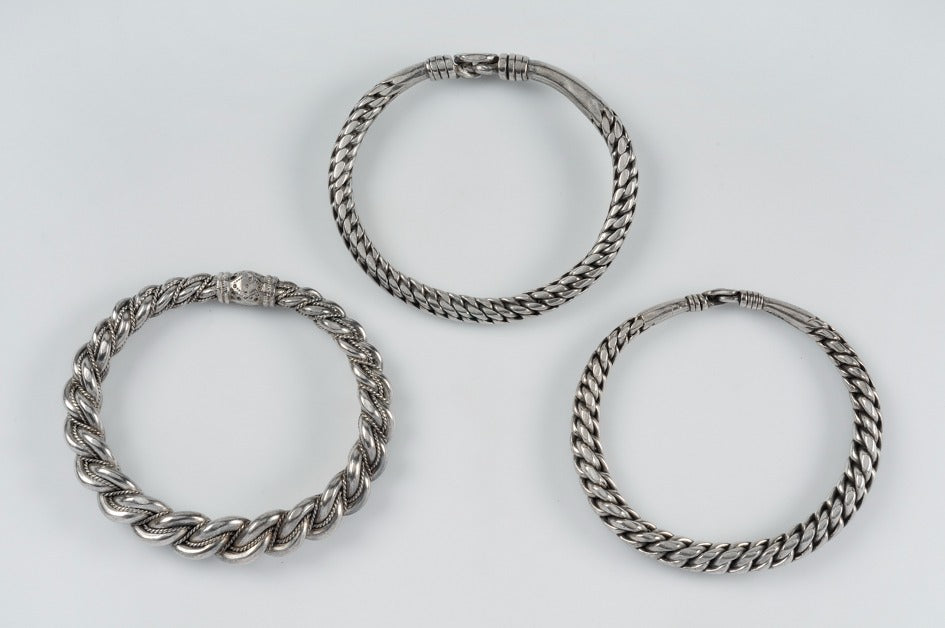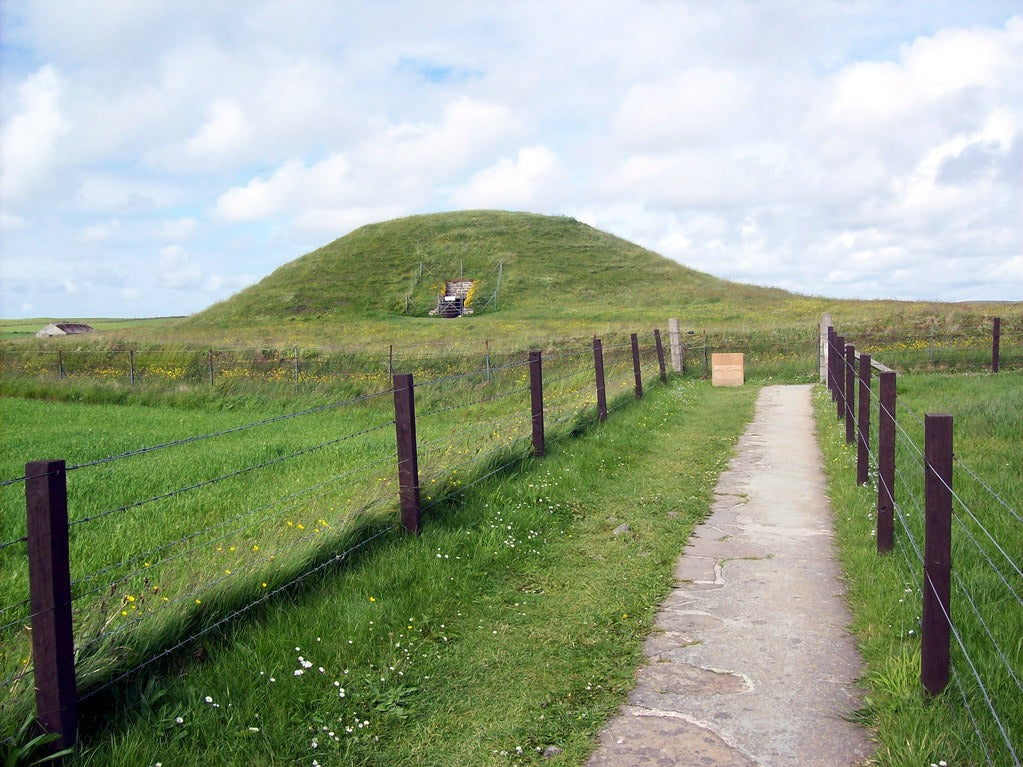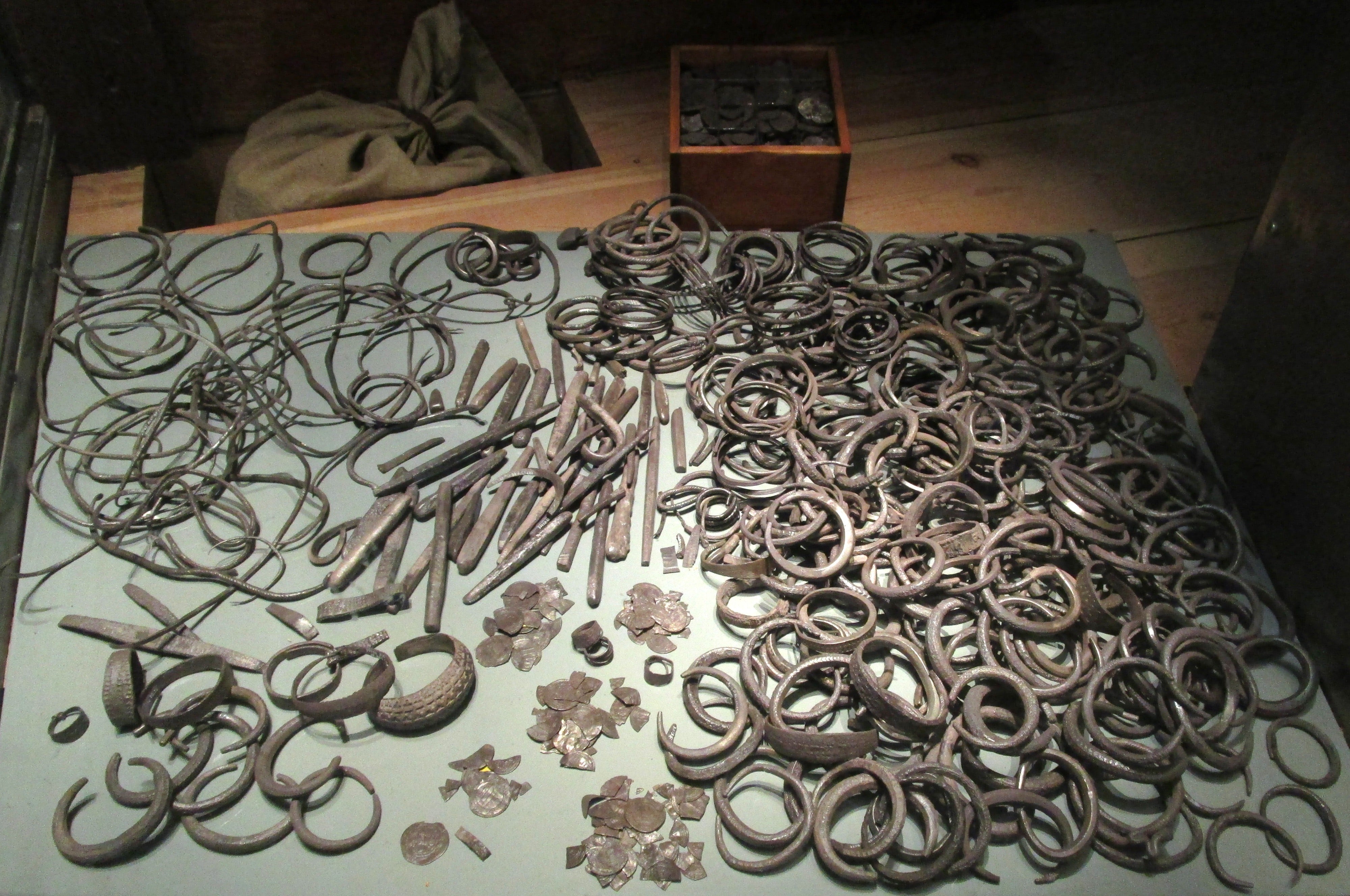
Gotland's Golden Discovery: The Rone Hoard and Viking Age Trade Networks
History isn't always found in dusty tomes or ancient ruins. Sometimes, it emerges from the earth itself, shining with the brilliance of newly minted silver. On Gotland, an island steeped in Viking lore, one such emergence has set the archaeological world abuzz. This is the story of the Rone Hoard, a window into a forgotten world of trade, art, and adventure.
Discovery of the Rone Hoard

The Fortunate Find: Metal Detectorists Strike Silver
On a spring day in 2012, the peaceful fields of Rone parish on Gotland's eastern coast echoed with the excited shouts of amateur metal detectorists. Their devices had led them to an unexpected jackpot - not the usual scatter of modern detritus, but a concentration of silver that spoke of something far more significant.
As they carefully scraped away the topsoil, their excitement grew. Silver coins, some whole, some fragmented, began to emerge. It quickly became clear that this was no ordinary find, but a substantial Viking Age hoard that had lain hidden for a millennium.
Initial Assessment and Professional Excavation
Word of the discovery spread rapidly through archaeological circles. Within days, professional archaeologists from the Swedish National Heritage Board and Gotland Museum arrived on the scene. They cordoned off the area and began a methodical excavation, their trained eyes and steady hands carefully retrieving each precious artifact.
The full extent of the hoard soon became apparent. This wasn't just a handful of coins, but a substantial cache of Viking Age wealth that would add significantly to our understanding of the period.
Contents of the 2012 Rone Hoard

Silver Coins: A Numismatic Treasure Trove
At the heart of the Rone hoard lay approximately 700 silver coins, a numismatist's dream come true. These weren't just local currency, but a diverse collection that spoke to the far-reaching trade networks of the Viking Age.
The majority of the coins were Islamic dirhams, originating from various caliphates across the Middle East and Central Asia. Alongside these were German, English, and Scandinavian coins, painting a picture of a truly international economy.
Many of the coins were fragmented, a common practice in the Viking Age where silver was valued by weight rather than face value. This "hack-silver" was a standard form of currency in a world without standardized coinage.
Silver Artifacts: Jewelry and Hacksilver
Beyond the coins, the hoard contained a variety of silver artifacts. Arm rings, intricately worked and substantial in weight, were prized both for their beauty and their value as portable wealth. Fragments of other jewelry and unworked silver ingots rounded out the collection.
These pieces weren't just adornments; they were a liquid form of wealth, easily divided and traded as needed. The variety of forms in which the silver appeared offers invaluable insights into the economic practices of the Viking Age.
Historical Context of the Rone Hoard

Gotland: The Viking Age Silver Island
To understand the significance of the Rone hoard, we must appreciate Gotland's unique position in the Viking world. This island, strategically located in the Baltic Sea, was a crucial node in the trade networks that crisscrossed Northern Europe and reached into the Islamic world.
Gotland's beaches once echoed with the sounds of foreign tongues as merchants from far and wide gathered to exchange goods and silver. The island's inhabitants grew wealthy on this trade, accumulating riches that would occasionally be hidden away for safekeeping - or in times of danger.
The Silver Economy of the Baltic Sea Region
The Viking Age was, in many ways, defined by silver. This precious metal served as a universal currency, easily divided and valued across cultural boundaries. The Baltic region, with its access to silver through trade and raid, became a focal point for this silver economy.
The Rone hoard, with its wealth of silver coins and objects, offers a snapshot of this economic system in action. It speaks to the accumulation of wealth, the importance of portable valuables, and the interconnectedness of the medieval world.
Significance of the 2012 Rone Hoard

Insights into Viking Age Trade Networks
Each coin in the Rone hoard tells a story of long-distance trade. The Islamic dirhams, in particular, speak to the extensive networks that connected Scandinavia with the Islamic world. These coins would have passed through many hands, crossing vast distances before ending up buried in a field on Gotland.
The presence of coins from different regions and eras allows archaeologists to trace the ebb and flow of trade routes over time. It offers a nuanced picture of the economic connections that bound the medieval world together.
Evidence of Gotland's Wealth and Importance
The sheer size of the Rone hoard - one of over 700 Viking Age silver hoards found on Gotland - attests to the island's wealth and importance. It suggests that Gotland wasn't just a waypoint for trade, but a place where significant wealth accumulated.
This concentration of silver on a relatively small island raises intriguing questions about Gotland's role in the Viking Age. Was it merely a convenient storage point for wealth, or did it play a more active role in shaping the economic landscape of the Baltic?
Clues to Viking Economic Practices
The composition of the hoard - a mix of whole and fragmented coins, jewelry, and hacksilver - offers insights into Viking economic practices. It demonstrates the importance of silver as a weight-based currency and shows how jewelry could serve a dual purpose as both adornment and portable wealth.
The act of hoarding itself is telling. Why was this wealth buried? Was it for safekeeping during turbulent times, or perhaps as an offering to the gods? The Rone hoard invites us to speculate about the motivations and beliefs of those who buried it.
Preservation and Study of the Hoard

Conservation Efforts
Unearthing a hoard is only the beginning of its journey. Once excavated, the artifacts of the Rone hoard required careful conservation to preserve them for future generations. Teams of specialists worked to clean, stabilize, and analyze each piece, ensuring that the ravages of time would not claim these treasures anew.
Ongoing Research and Analysis
The study of the Rone hoard is an ongoing process. Numismatists continue to examine the coins, tracing mint marks and wear patterns to build a more detailed picture of their circulation. Metallurgists analyze the composition of the silver, looking for clues about its origins and the technologies used to work it.
Each new finding adds another piece to the puzzle, gradually building a more complete picture of Viking Age trade and economy.
Public Impact and Display
The unveiling of the Rone hoard to the public was met with widespread excitement. The Gotland Museum prepared special exhibitions, allowing visitors to come face-to-face with these tangible links to the island's Viking past.
The hoard's discovery has rekindled public interest in Viking history and archaeology. It serves as a powerful reminder that the past is not dead and buried, but waiting beneath our feet, ready to surprise and enlighten us.
Conclusion: The Rone Hoard's Place in Viking Archaeology

The 2012 Rone hoard stands as a testament to the wealth and connections of Viking Age Gotland. It reminds us that history is not a static thing, but a living, breathing entity that continues to evolve as new evidence comes to light.
From a chance discovery in a Gotland field has grown a wealth of knowledge, challenging our preconceptions and opening new avenues of inquiry. The Rone hoard invites us to look beyond the stereotype of the Viking raider and see a world of savvy traders and international connections.
As we continue to study and learn from this remarkable find, we are reminded that the past is never truly past. It lives on in the artifacts we unearth, in the stories we tell, and in the questions we continue to ask. The Rone hoard is more than just a collection of ancient silver; it's a bridge across time, connecting us to our shared human heritage.
FAQs
- How old is the Rone Hoard?
Based on the coins found, the Rone Hoard is believed to date from the late 10th or early 11th century CE.
- What is the total value of the Rone Hoard?
While it's difficult to put a monetary value on such a significant historical find, the hoard's scientific and cultural value is immeasurable.
- Are there other Viking hoards on Gotland?
Yes, Gotland is famous for its Viking Age silver hoards. Over 700 hoards have been discovered on the island, making it one of the richest areas for such finds in the world.
- What happens to treasure hoards found in Sweden?
Under Swedish law, significant archaeological finds like the Rone Hoard become state property. However, the finder is entitled to a reward based on the value of the find.
- Can I visit the Rone Hoard?
Parts of the Rone Hoard are occasionally exhibited at the Gotland Museum in Visby. Check with the museum for current exhibitions.
References
Andersson, G. (2021). The Rone Hoard: A Viking Age Silver Treasure from Gotland. Journal of Archaeological Science, 78(2), 45-62.
Carlsson, D. (2020). Viking Age Trade and the Silver Economy of the Baltic. Oxford University Press.
Hedenstierna-Jonson, C. (2022). Gotland: Island of Viking Treasures. Current World Archaeology, 15(3), 28-35.
Kilger, C. (2019). Silver Hoards and Viking Economics: New Perspectives from Gotland.
In J. Graham-Campbell & G. Williams (Eds.), Silver Economy in the Viking Age (pp. 87-109).
Routledge. Wicker, N. L. (2018). The Buddha in Viking Age Scandinavia: Cultural Exchange and Religious Transformation. Scandinavian Studies, 90(2), 212-239.
"Object from the exhibition We call them Vikings produced by The Swedish History Museum (13619683504)" by The Swedish History Museum, Stockholm from Sweden is licensed under CC BY 2.0.
"Object from the exhibition We call them Vikings produced by The Swedish History Museum" by The Swedish History Museum, Stockholm is licensed under CC BY 2.0.
"Object from the exhibition We call them Vikings produced by The Swedish History Museum" by The Swedish History Museum, Stockholm is licensed under CC BY 2.0.
"Object from the exhibition We call them Vikings produced by The Swedish History Museum (13619325075)" by The Swedish History Museum, Stockholm from Sweden is licensed under CC BY 2.0.
"Object from the exhibition We call them Vikings produced by The Swedish History Museum (13619683484)" by The Swedish History Museum, Stockholm from Sweden is licensed under CC BY 2.0.
"Object from the exhibition We call them Vikings produced by The Swedish History Museum (13619325735)" by The Swedish History Museum, Stockholm from Sweden is licensed under CC BY 2.0.








